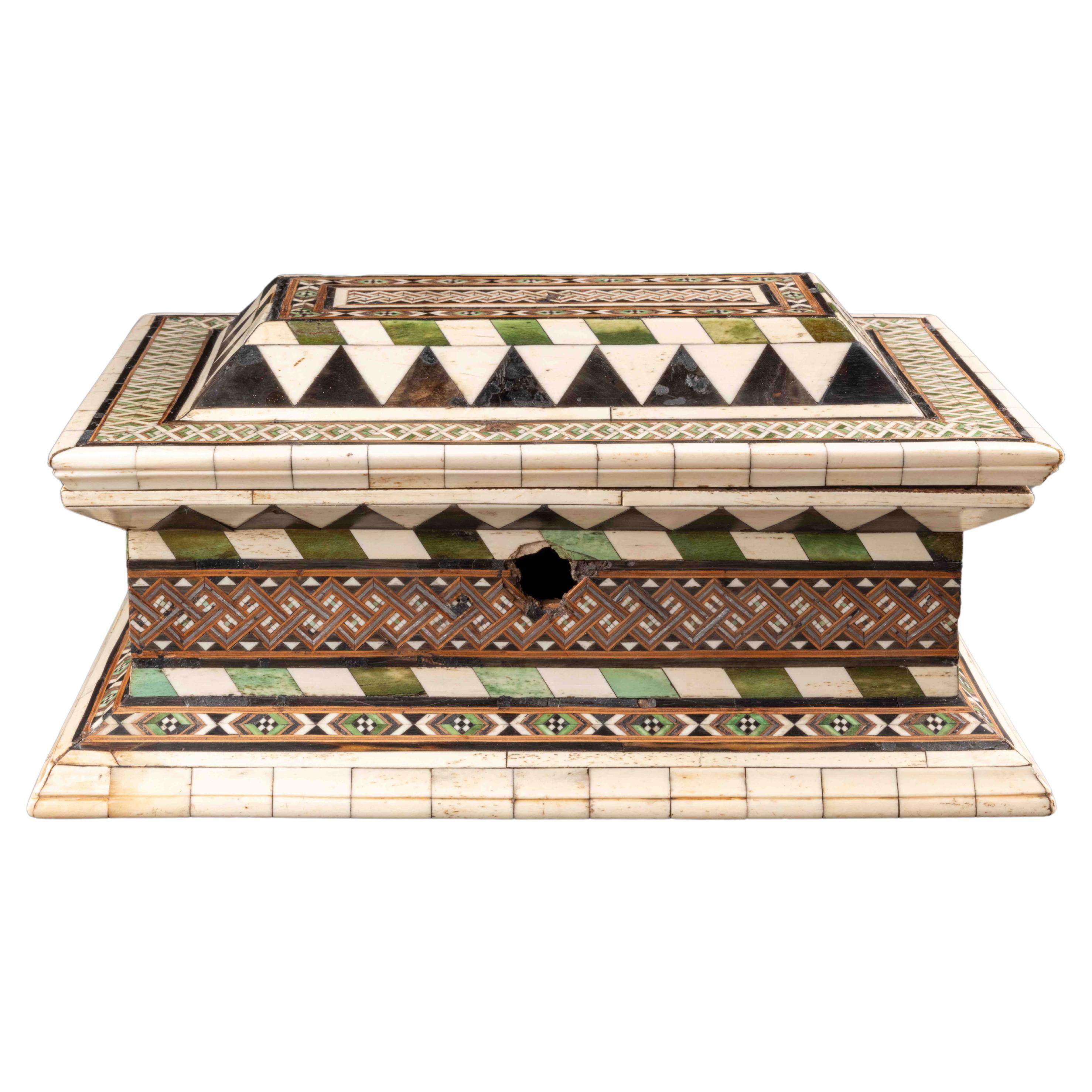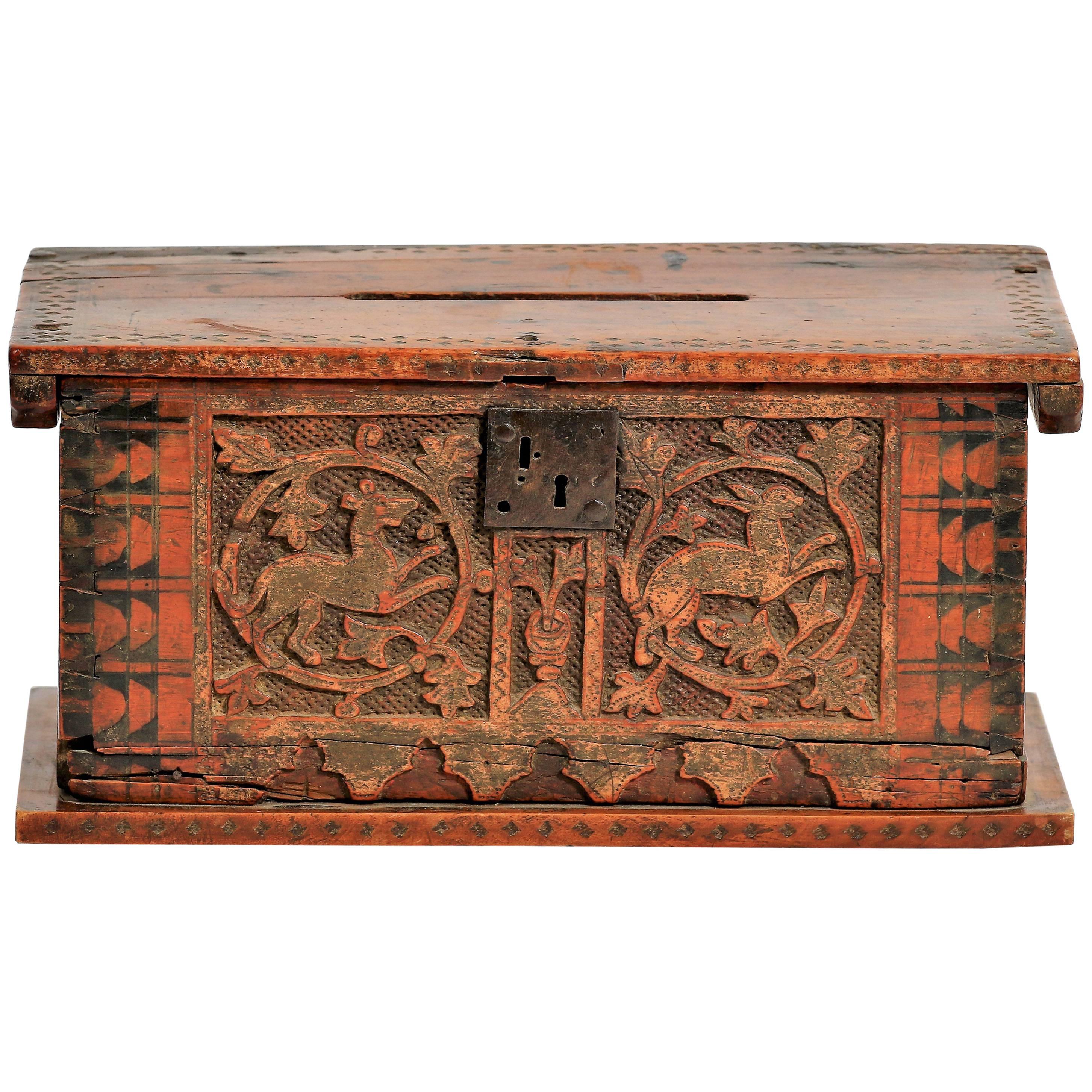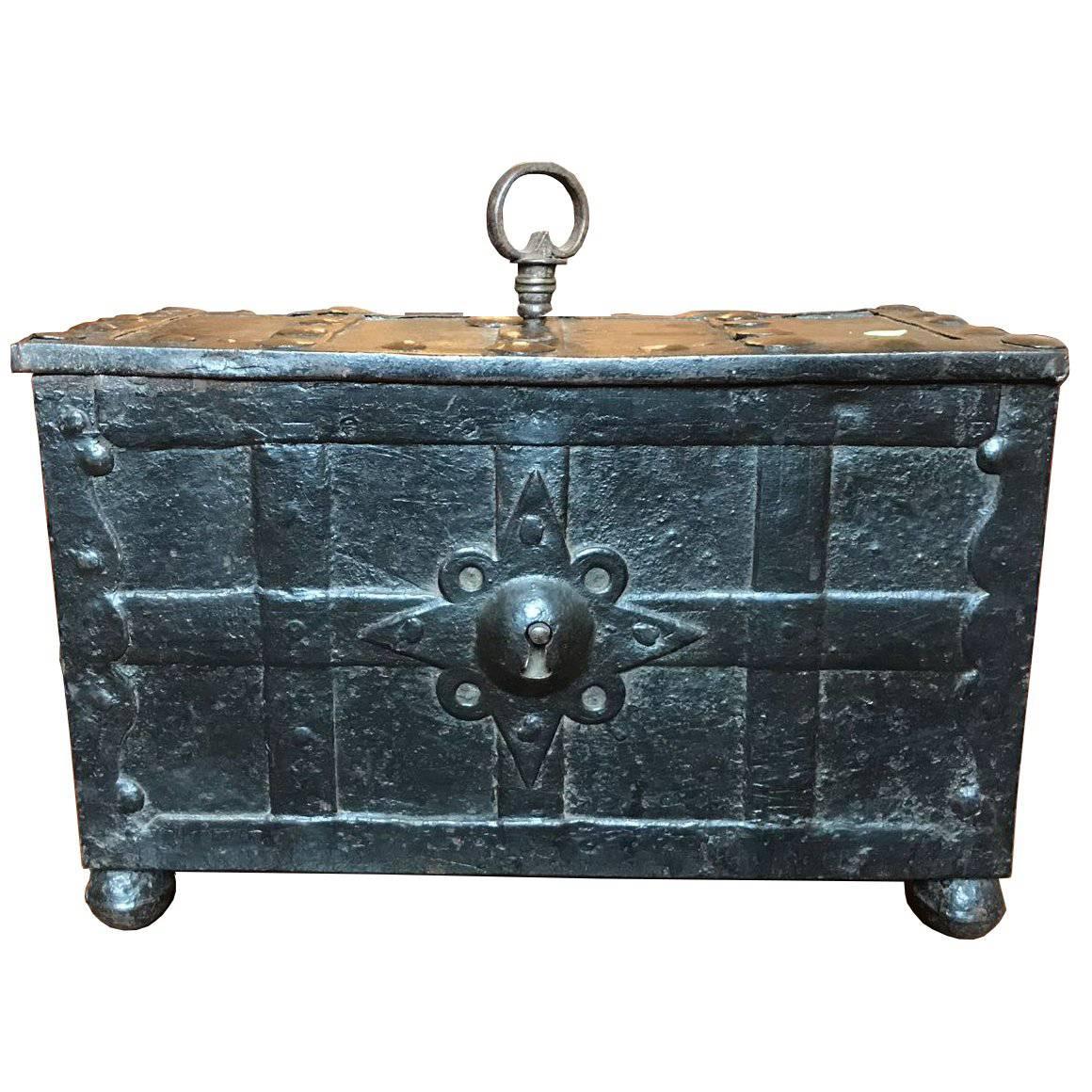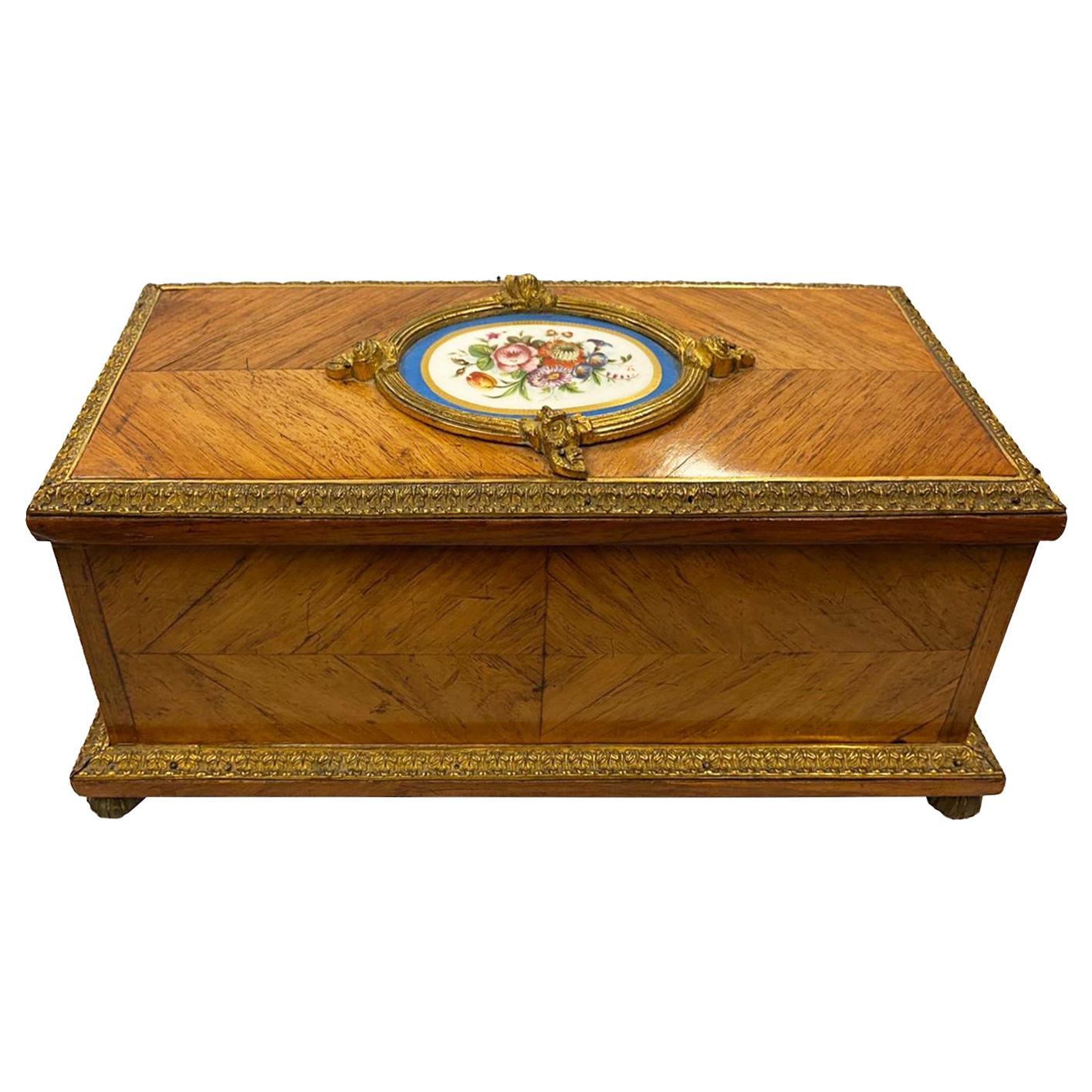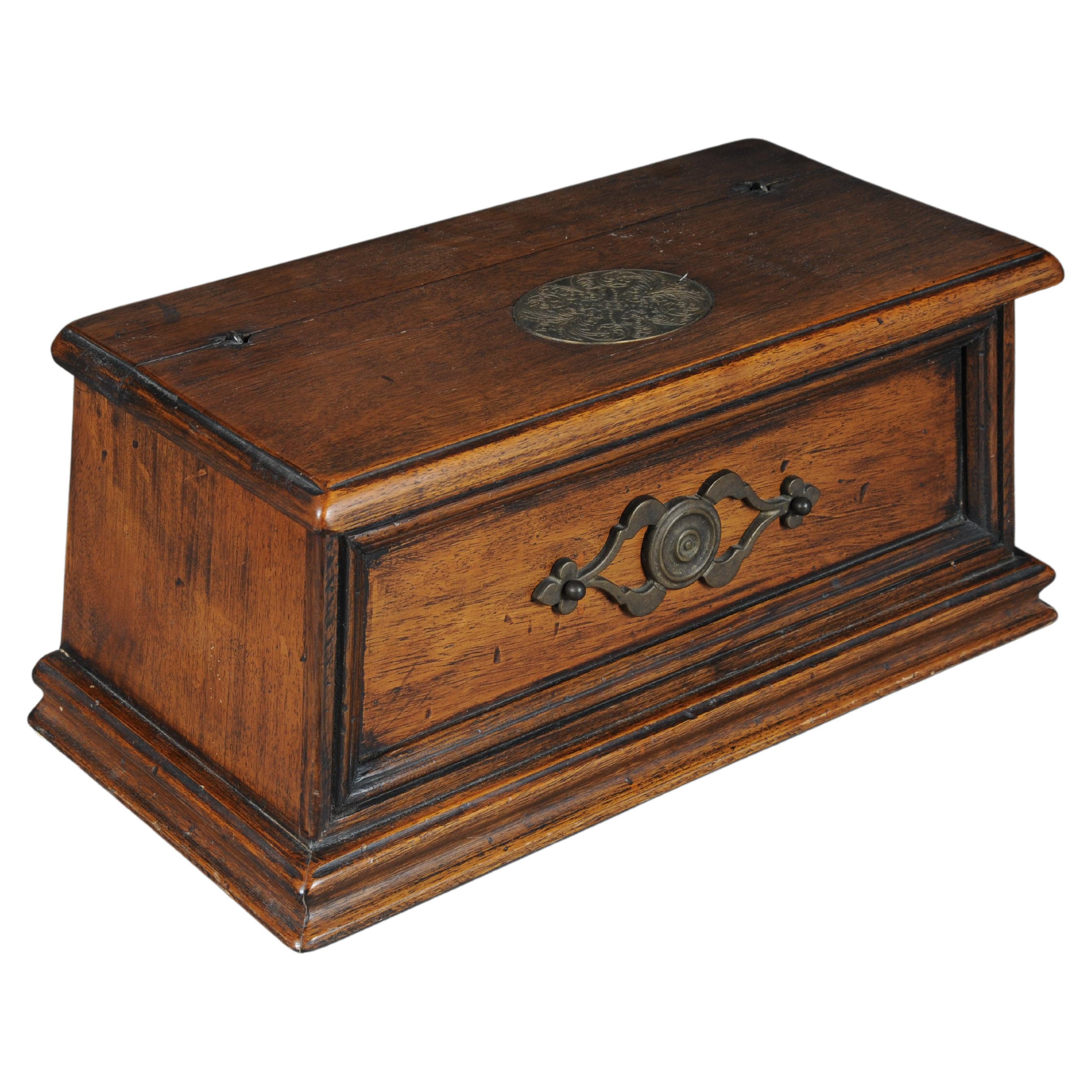Items Similar to Medieval Patinated Iron-Mounted Oak Casket, 15th Century
Want more images or videos?
Request additional images or videos from the seller
1 of 10
Medieval Patinated Iron-Mounted Oak Casket, 15th Century
About the Item
Medieval patinated iron-mounted oak casket, 15th century
A Continental Medieval patinated iron mounted oak wood box. 15th Century or earlier.
Additional information:
Style: Medieval
Primary Material: Mixed Materials
Material: Wood
Brand: Unmarked
Dimension: 7 inches x 5.75 inches x 4 inches
Condition: Losses to accents at top. The interior mounted hinge and screws are later replacements, locking mechanism is missing. Wood interior and all external elements are original.
- Dimensions:Height: 7 in (17.78 cm)Width: 5.75 in (14.61 cm)Depth: 4 in (10.16 cm)
- Style:Medieval (Of the Period)
- Materials and Techniques:Iron,Patinated
- Period:
- Date of Manufacture:15th Century or Earlier
- Condition:Replacements made: hinge and screws are replacements. Wear consistent with age and use. Minor losses.
- Seller Location:Gardena, CA
- Reference Number:
About the Seller
5.0
Platinum Seller
These expertly vetted sellers are 1stDibs' most experienced sellers and are rated highest by our customers.
1stDibs seller since 2022
46 sales on 1stDibs
Typical response time: 6 hours
- ShippingRetrieving quote...Ships From: Gardena, CA
- Return PolicyA return for this item may be initiated within 7 days of delivery.
More From This SellerView All
- German, Dutch Hand Carved Wood Chest Box or Trunk w. Iron Mounts, 18th CenturyLocated in Gardena, CAGerman - Dutch Hand Carved Wood Chest Box or Trunk w. Iron Mounts, 18th Century 18th century German - Dutch hand carved wood chest box or tr...Category
Antique 18th Century Decorative Boxes
MaterialsWood
- Continental Porcelain Trinket Box W/ Patinated Bronze Hinges, 18th-19th CenturyLocated in Gardena, CAContinental porcelain trinket box w/ patinated bronze hinges, 18th-19th century. Charming hand painted idyllic outdoor scene of a courting couple with...Category
Antique 19th Century Decorative Boxes
MaterialsPorcelain
- Italian Ancient Coin Mounted Wood Cigar Box Humidor, 19th CenturyLocated in Gardena, CAItalian Ancient Coin Mounted Wood Cigar Box Humidor, 19th Century Italian coin mounted wood cigar box, 19th Century. 50 Italian coins mounted to the exterior walls and lid. Fabric to the interior. The Fleur-dis-lis designs were likely added at a later date. Additional information: Featured Refinements:Wooden Cigar Box...Category
Antique 19th Century Cigar Boxes and Humidors
MaterialsWood
- American Brass Mounted Large Cigar Humidor Box with Lid, 2nd Quarter 20th CLocated in Gardena, CAAmerican brass mounted large cigar humidor box with lid, 2nd quarter 20th cen. 2nd quarter 20th century. Thick lobed blown glass sectioned off by foliate brass panels. Leaf design...Category
20th Century American Cigar Boxes and Humidors
MaterialsBrass
- American Sterling Silver Mounted Cigar BoxLocated in Gardena, CAAmerican sterling silver marked mounted cigar box Three indentations in box indicates there was once a divider in place. Divider missing. Additional information: Composition: ...Category
20th Century Cigar Boxes and Humidors
MaterialsSterling Silver
- Carved Wood Patinated and Gilt Metal Treasure Chest Form Decanter Tantalus BoxLocated in Gardena, CACarved wood patinated and gilt metal treasure chest form decanter tantalus box circa 1920. Wood box with divided interior to fit 6 decanters, patinated...Category
20th Century Decorative Boxes
MaterialsWood
You May Also Like
- Embriachi workshop marquetry casket - Northern Italy, 15th centuryLocated in Bruxelles, BEEmbriachi workshop marquetry casket Northern Italy, 15th century Alla certosina inlays (bone, stained bone, pewter and wood) H 28.2 x W 18 x D 14 cm This beautiful casket of rectangular form is richly decorated with the characteristic geometric patterns of the Embriachi style. The intricate geometric patterns are fashioned by juxtaposing lighter and darker pieces of wood, (colored) bone, horn and pewter. The lid and base are framed by a broad band of horn. When ivory became scarce in Europe due to disrupted trade routes, bone was substituted. The attention to Symmetry and balance created an harmonious visual effect Enhancing the overall aesthetic appeal of the casket. The application of geometrical motifs is in Italy known as marquetry ‘alla Certosina’, named after the Certosina Church in Pavia with its famous altarpiece decorated in this way. This is ‘intarsia technique’, a term derived from the Arabic 'tarsi', which means ‘incrustation' recalling ancient mosaics made from various materials. These geometric elements not only enhance the aesthetic appeal of the caskets but also demonstrate the versatility and skill of the artisans in creating multifaceted works of art. ‘Alla Certosina’ became famous through the Northern Italian Embriachi family who achieved a particularly high standard in working in this technique. Venice in particular was known for the production of these luxurious boxes. The caskets, hexagonal or rectangular, surmounted by a lid decorated in several registers constitute the secular, albeit equally renowned component of the workshop’s production, in addition to mirror frames and various everyday objects. The method of fabrication of those objects was based on two concepts that underlay pre-industrial production: standardization and modularity, thanks to a distribution of skills according to the different phases of fabrication. even the realization of the marquetry motifs (in the form of ingots from which portions of the desired size were cut) were therefore entrusted to various specialized craftsmen, as were the assembly phase. Today better known thanks to the extensive research work recently carried out by Michele Tomasi, this workshop owes its name to its founder and owner, the Florentine Baldassare Ubriachi (or degli Embriachi), a merchant and banker established in the Tuscan capital before he settled in Venice in 1395. Together with sculptor Giovanni di Jacopo, who directed the workshop, from the last years of the fourteenth century, Baldassare oversaw a production that was truly original, and still easily recognizable today, comprising monumental altarpieces and various objects, primarily triptychs and caskets. The precise location of the workshop is unknown, except that it originated in Florence and in ca. 1431 there was apparently a workshop in Venice, in the area of S Luca. They employed local workers specializing in 'certosina' (inlay of stained woods, bone and horn), and the workshop produced items carved in bone (usually horse or ox) with wood and bone marquetry. The geometric decoration of Embriachi caskets reflects the artistic complexity and attention to detail that characterized their work. this inlaid casket is a testament to the skill and artistry of the Embriachi family and serves as a stunning example of the decorative arts of the late Middle Ages. Related Literature : E. Berger, Prunk-Kassetten: Europäischen Meisterwerke aus acht Jahrhunderten / Ornamental Caskets...Category
Antique 15th Century and Earlier Italian Renaissance Decorative Boxes
MaterialsPewter
- Very Rare Casket Minnekästchen or Box, Germany or Italy, 15th CenturyLocated in Beuzevillette, FRWooden coffret, call minnekästchen, engraved with a dog, a hare and foliage with polychromy remains. During the Middle Age, the hare is a symbol of fertility, joy and represents the Christ...Category
Antique 15th Century and Earlier European Gothic Decorative Boxes
MaterialsIron
- Square Belgium 18th Century Baroque Oak And Iron CasketLocated in Haddonfield, NJSquare Belgium 18th century Baroque oak and iron casket.Category
Antique Mid-18th Century Belgian Baroque Decorative Boxes
MaterialsBrass, Iron
- Early 17th Century Medieval Handcrafted Black Iron German CofferLocated in Brescia, ITThe iron coffer, fully original in every part of it, was forged and handcrafted in German in the 1610. Complete with key. Full working iron mechanisms. It ...Category
Antique Early 17th Century German Medieval Decorative Boxes
MaterialsIron
- French 19th Century 'Sevres' Porcelain Mounted CasketBy Tahan ParisLocated in Brighton, SussexA fine quality late 19th century gilded ormolu and Sevres style porcelain mounted casket, the hinged lid opening to a silk lined interior (needing repair) and raised on ormolu melon ...Category
Antique Late 19th Century French Louis XVI Decorative Boxes
MaterialsPorcelain, Walnut
- 19th Century Antique Oak Briefnbox/Casket, GermanyLocated in Berlin, DE19th Century Antique Oak Briefnbox/Casket, Germany Rectangular solid oak body with fittings. The box is relatively large and wide and offers a lot of space. The box can be used in m...Category
Antique 19th Century German Decorative Boxes
MaterialsIron
